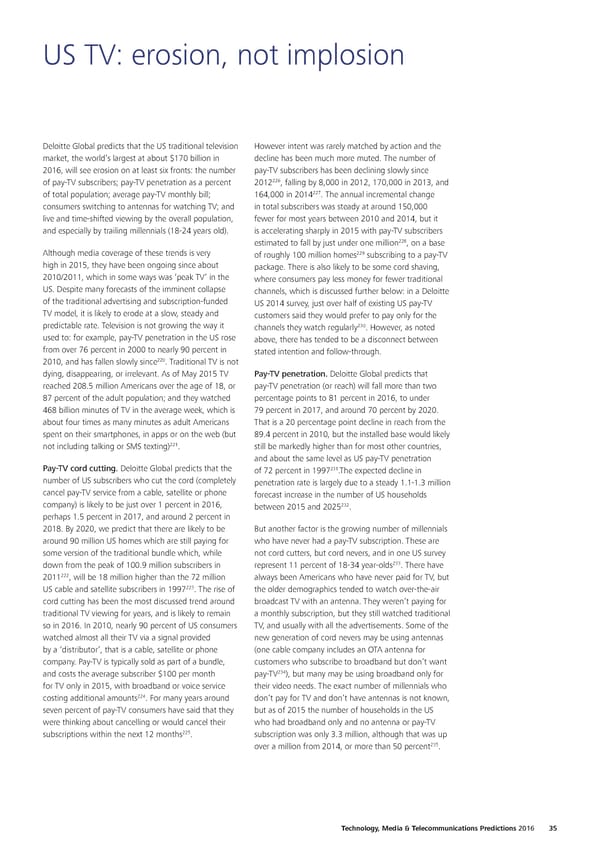US TV: erosion, not implosion Deloitte Global predicts that the US traditional television However intent was rarely matched by action and the market, the world’s largest at about $170 billion in decline has been much more muted. The number of 2016, will see erosion on at least six fronts: the number pay-TV subscribers has been declining slowly since 226 of pay-TV subscribers; pay-TV penetration as a percent 2012 , falling by 8,000 in 2012, 170,000 in 2013, and 227 of total population; average pay-TV monthly bill; 164,000 in 2014 . The annual incremental change consumers switching to antennas for watching TV; and in total subscribers was steady at around 150,000 live and time-shifted viewing by the overall population, fewer for most years between 2010 and 2014, but it and especially by trailing millennials (18-24 years old). is accelerating sharply in 2015 with pay-TV subscribers 228 estimated to fall by just under one million , on a base Although media coverage of these trends is very 229 of roughly 100 million homes subscribing to a pay-TV high in 2015, they have been ongoing since about package. There is also likely to be some cord shaving, 2010/2011, which in some ways was ‘peak TV’ in the where consumers pay less money for fewer traditional US. Despite many forecasts of the imminent collapse channels, which is discussed further below: in a Deloitte of the traditional advertising and subscription-funded US 2014 survey, just over half of existing US pay-TV TV model, it is likely to erode at a slow, steady and customers said they would prefer to pay only for the predictable rate. Television is not growing the way it 230 channels they watch regularly . However, as noted used to: for example, pay-TV penetration in the US rose above, there has tended to be a disconnect between from over 76 percent in 2000 to nearly 90 percent in stated intention and follow-through. 220 2010, and has fallen slowly since . Traditional TV is not dying, disappearing, or irrelevant. As of May 2015 TV Pay-TV penetration. Deloitte Global predicts that reached 208.5 million Americans over the age of 18, or pay-TV penetration (or reach) will fall more than two 87 percent of the adult population; and they watched percentage points to 81 percent in 2016, to under 468 billion minutes of TV in the average week, which is 79 percent in 2017, and around 70 percent by 2020. about four times as many minutes as adult Americans That is a 20 percentage point decline in reach from the spent on their smartphones, in apps or on the web (but 89.4 percent in 2010, but the installed base would likely 221 not including talking or SMS texting) . still be markedly higher than for most other countries, and about the same level as US pay-TV penetration Pay-TV cord cutting. Deloitte Global predicts that the 231 of 72 percent in 1997 .The expected decline in number of US subscribers who cut the cord (completely penetration rate is largely due to a steady 1.1-1.3 million cancel pay-TV service from a cable, satellite or phone forecast increase in the number of US households company) is likely to be just over 1 percent in 2016, 232 between 2015 and 2025 . perhaps 1.5 percent in 2017, and around 2 percent in 2018. By 2020, we predict that there are likely to be But another factor is the growing number of millennials around 90 million US homes which are still paying for who have never had a pay-TV subscription. These are some version of the traditional bundle which, while not cord cutters, but cord nevers, and in one US survey 233 down from the peak of 100.9 million subscribers in represent 11 percent of 18-34 year-olds . There have 222 2011 , will be 18 million higher than the 72 million always been Americans who have never paid for TV, but 223 US cable and satellite subscribers in 1997 . The rise of the older demographics tended to watch over-the-air cord cutting has been the most discussed trend around broadcast TV with an antenna. They weren’t paying for traditional TV viewing for years, and is likely to remain a monthly subscription, but they still watched traditional so in 2016. In 2010, nearly 90 percent of US consumers TV, and usually with all the advertisements. Some of the watched almost all their TV via a signal provided new generation of cord nevers may be using antennas by a ‘distributor’, that is a cable, satellite or phone (one cable company includes an OTA antenna for company. Pay-TV is typically sold as part of a bundle, customers who subscribe to broadband but don’t want 234 and costs the average subscriber $100 per month pay-TV ), but many may be using broadband only for for TV only in 2015, with broadband or voice service their video needs. The exact number of millennials who 224 costing additional amounts . For many years around don’t pay for TV and don’t have antennas is not known, seven percent of pay-TV consumers have said that they but as of 2015 the number of households in the US were thinking about cancelling or would cancel their who had broadband only and no antenna or pay-TV 225 subscriptions within the next 12 months . subscription was only 3.3 million, although that was up 235 over a million from 2014, or more than 50 percent . Technology, Media & Telecommunications Predictions 2016 35
 Technology, Media & Telecommunications Predictions Page 41 Page 43
Technology, Media & Telecommunications Predictions Page 41 Page 43